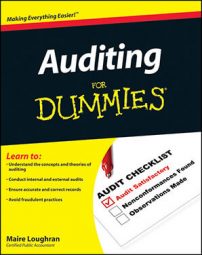Audit evidence documents give you the substantiation for your professional audit opinion. When performing an audit, you must assess the nature, competence, sufficiency, and evaluation of the audit evidence to determine its accuracy. After all your audit depends on the veracity of the evidence.
The nature of the audit evidence
The nature of audit evidence refers to the form of the evidence you’re looking at during the audit. It should include all accounting documents and may include other available information, such as meeting minutes of the board of directors.
Here are some examples of books:
General ledger: A file of all financial accounts, usually by account number, that shows all events that affected each account during the month.
Subsidiary ledger: A file that shows more detailed information than is shown on the general ledger.
Journals: Day-by-day records of transactions.
Here are some examples of records, which are also known as source documents:
Invoices from suppliers that show what the business ordered and how much it cost.
Z-tapes from cash registers that show daily sales in a retail shop. The Z-tape is the company’s version of the cash register tape you receive with your purchase, but the company’s Z-tape lists all sales made during the day.
Customer invoices that show what customers purchased from the company and how much it cost.
Time cards that show how many hours an employee worked during a pay period.
The competence of the audit evidence
Competence refers to the quality of the audit evidence, regardless of whether the evidence is written, oral, or observed.
The term competence also refers to whether the audit evidence is relevant to the work you’re doing and whether it’s reliable. Relevant and reliable are two staple auditing terms. They both focus on the quality of the supporting documentation and the audit tests performed.
Relevance: You measure relevance by assessing the relationship between the documentation and the management assertion you’re testing.
Reliability: You measure reliability by deciding whether the evidence is credible. As an auditor, you should adopt an attitude of professional skepticism.
A third party can verify reliable evidence. For example, to verify that your client made a payment, you need more than a copy of a check or a check stub. Look for a canceled check that shows endorsement by the person or business to which it was payable (the payee). Also, you can look for the Magnetic Ink Character Recognition (MICR) coding, which shows that it cleared through your client’s bank account.
Keep these facts about reliability in mind:
Original source documents are more reliable than copies, which can easily be altered from the original.
Written documentation is more reliable than oral.
Your direct knowledge of a process is more reliable than merely having an employee describe to you how it works.
The sufficiency of the audit evidence
The sufficiency of audit evidence is the amount or quantity of audit evidence. You determine the amount of audit evidence you need by considering the risk of material misstatement and the overall quality of the evidence you receive.
Most of the time, you rely on evidence that’s persuasive rather than convincing. What’s the difference?
Persuasive evidence tips the scale one way or the other and provides you with a basis beyond a reasonable doubt for forming an opinion. Here’s an example of persuasive evidence: Your job is to verify the current accounts receivable balance of $50,000. To accomplish this, you send confirmation letters to the client’s 20 largest customers. The sum of these customers’ accounts receivable balances is $37,500, which is 75 percent of the total — the percentage your senior associate told you to check. If all the customers reply with positive responses (meaning they confirm that they owe your client the amounts shown in accounts receivable), you have enough persuasive evidence to issue an opinion on the accuracy of the overall accounts receivable balance.
Convincing evidence is perfectly reliable. You’d have to look at all the client’s records to achieve this level of assertion — something that’s never done during an audit. Reaching this level of evidence isn’t feasible, because you have to complete an audit during a limited amount of time and for a reasonable cost. Convincing evidence would be if you sent confirmation letters to all customers and pursued all customers until they responded.
The evaluation of the audit evidence
The last concept of audit evidence is making sense of the evidence the client has given you and seeing whether you have enough competent evidence to support management assertions. This step involves using your professional judgment to make sure the evidence you’ve gathered is appropriate (relevant and reliable) and sufficient.

